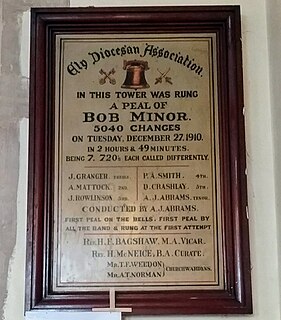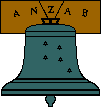
Change ringing is the art of ringing a set of tuned bells in a tightly controlled manner to produce precise variations in their successive striking sequences, known as "changes". This can be by method ringing in which the ringers commit to memory the rules for generating each change, or by call changes, where the ringers are instructed how to generate each change by instructions from a conductor. This creates a form of bell music which cannot be discerned as a conventional melody, but is a series of mathematical sequences.

The Whitechapel Bell Foundry was a business in the London Borough of Tower Hamlets. At the time of the closure of its Whitechapel premises, it was the oldest manufacturing company in Great Britain. The bell foundry primarily made church bells and their fittings and accessories, although it also provided single tolling bells, carillon bells and handbells. The foundry was notable for being the original manufacturer of the Liberty Bell, a famous symbol of American independence, and for re-casting Big Ben, which rings from the north clock tower at the Houses of Parliament in London.
Campanology is the scientific and musical study of bells. It encompasses the technology of bells – how they are founded, tuned, and rung – as well as the history, methods, and traditions of bellringing as an art.

A bell is a directly struck idiophone percussion instrument. Most bells have the shape of a hollow cup that when struck vibrates in a single strong strike tone, with its sides forming an efficient resonator. The strike may be made by an internal "clapper" or "uvula", an external hammer, or—in small bells—by a small loose sphere enclosed within the body of the bell.
A handbell is a bell designed to be rung by hand. To ring a handbell, a ringer grasps the bell by its slightly flexible handle – traditionally made of leather, but often now made of plastic – and moves the arm to make the hinged clapper strike the inside of the bell. An individual handbell can be used simply as a signal to catch people's attention or summon them together, but handbells are also often heard in tuned sets.
Method ringing is a form of change ringing in which the ringers commit to memory the rules for generating each change of sequence, and pairs of bells are affected. This creates a form of bell music which is continually changing, but which cannot be discerned as a conventional melody. It is a way of sounding continually changing mathematical permutations.
The Oxford University Society of Change Ringers, founded in 1872, is the official society dedicated to change ringing in Oxford University. Its objects are to promote the art of change ringing in the University and to ring for Sunday services in Oxford during full term.

The Nottingham University Society of Change Ringers (NUSCR) is one of the oldest societies affiliated to the University of Nottingham Students' Union, being founded in 1958. Its principal aim is to allow students from both the University of Nottingham and Nottingham Trent University to practise English Change Ringing. It also represents the University at the annual Northern Universities Association (NUA) Striking Competition each November.
The Ancient Society of College Youths (ASCY) is a change ringing society, founded in 1637 and based in the City of London. The society played a leading role in the early development of change ringing, and today provides ringers for important events at St Paul's Cathedral and Westminster Abbey. Although it is a non-territorial association, its importance is recognised through having four representatives on the Central Council of Church Bell Ringers.

In campanology, a peal is the special name given to a specific type of performance of change ringing which meets certain exacting conditions for duration, complexity and quality.
Grandsire is one of the standard change ringing methods, which are methods of ringing church bells or handbells using a series of mathematical permutations rather than using a melody. The grandsire method is usually rung on an odd number of bells: Grandsire doubles is rung on five working bells, grandsire triples on seven, grandsire caters on nine and grandsire cinques on eleven. Like all odd-bell methods, where there are sufficient bells, it is normally rung with a "cover" bell, which stays in the last position in each row to add musicality.
Fabian Stedman (1640–1713) was an English author and a leading figure in the early history of campanology, particularly in the field of method ringing. He had a key role in publishing two books Tintinnalogia and Campanalogia which are the first two publications on the subject. He is also regarded as being a pioneer in the branch of mathematics known as Group theory.
John Holt was a leading change ringer and noted composer of peals on English full circle bells in the 18th century, and is described as a composer "..holding a position which is unique in the history of change ringing".

Ufford is a village and civil parish in Suffolk, England. Its population of 808 at the 2001 census rose to 948 at the 2011 Census and was estimated at 1,008 in 2019. The village lies 2 miles south-south-west of Wickham Market and 13 miles north-east of Ipswich. The main road through the village was renumbered B1438 after its replacement as a trunk road by the new A12.
The Central Council of Church Bell Ringers (CCCBR) is an organisation founded in 1891 which represents ringers of church bells in the English style.
The Royal Jubilee Bells are a set of eight bells that were cast for the church of St James Garlickhythe in the City of London, which were seen on television around the world leading the Thames Diamond Jubilee Pageant on 3 June 2012 for the Diamond Jubilee of Elizabeth II.

The Australian and New Zealand Association of Bellringers, known as ANZAB, is the organisation responsible for the promotion of English-style "full circle ringing" – namely change ringing and method ringing in bell towers with a peal of bells – across Australia and New Zealand.
Albert John Pitman is regarded by change ringing campanologists as a remarkable and versatile composer of peals in bell ringing methods. Described as 'perhaps the greatest of all time' in the Central Council of Church Bell Ringers biography of him, An Unassuming Genius, he was an extraordinary talent in the field of peal composition.

The Suffolk Guild of Ringers for the Diocese of St Edmundsbury and Ipswich is a society and charity supporting the bell ringers and rings of bells in the Diocese of St Edmundsbury and Ipswich who practice the art of change ringing. The Guild was established in 1923 at Ipswich and covers over 200 rings of bells in the county of Suffolk in the area that falls within the diocese boundary.
Campanology is the scientific and musical study of bells. It encompasses the technology of bells – how they are cast, tuned, and rung – as well as the history, methods, and traditions of bellringing as an art. Articles related to campanology include:








